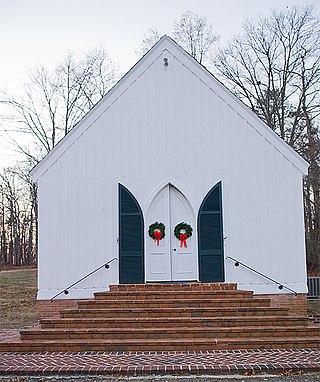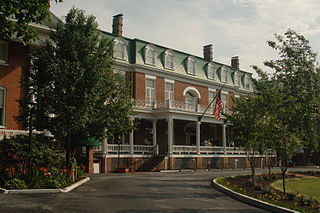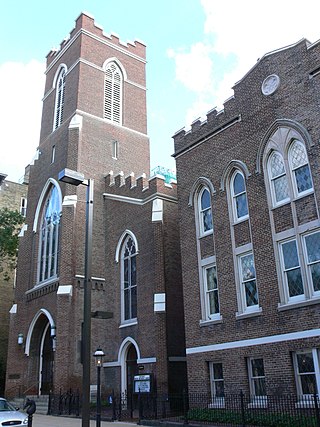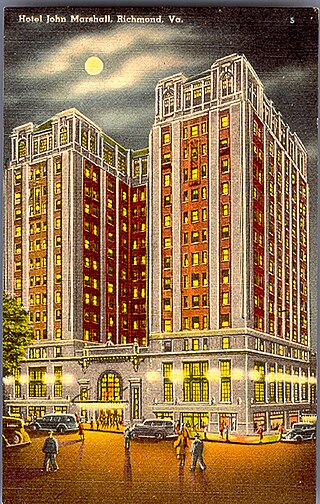
Charles Morrison Robinson, most commonly known as Charles M. Robinson, was an American architect. He worked in Altoona and Pittsburgh, Pennsylvania from 1889 to 1906 and in Richmond, Virginia from 1906 until the time of his death in 1932. He is most remembered as a prolific designer of educational buildings in Virginia, including public schools in Richmond and throughout Virginia, and university buildings for James Madison University, College of William and Mary, Radford University, Virginia State University, University of Mary Washington, and the University of Richmond. He was also the public school architect of the Richmond Public Schools from 1910 to 1929. Many of his works have been listed on the National Register of Historic Places.

Bremo Slave Chapel, constructed in 1835 and located in Bremo Bluff, Virginia, United States, is the only slave chapel known to exist in the Commonwealth of Virginia. This Gothic Revival structure originally served as a place of worship for the slaves at the Bremo Plantation of General John Hartwell Cocke. Cocke was deeply concerned with the religious and moral state of his slaves, which drove him to construct this chapel.

Grace Episcopal Church is a historic Episcopal church located at 5607 Gordonsville Road in Keswick, Albemarle County, Virginia, United States. The Gothic Revival building was designed by architect William Strickland in 1847. It is the only known work of Strickland in Virginia. The interior was rebuilt after a fire in 1895.

This is a list of the National Register of Historic Places listings in Albemarle County, Virginia.

This is a list of the National Register of Historic Places listings in Frederick County, Virginia.

Willis Presbyterian Church and Cemetery, also known as Grace Baptist Church, is a historic Presbyterian church and cemetery in Willis, Floyd County, Virginia. It was built in 1954, and is one of six "rock churches" founded by Bob Childress and built between 1919 and the early 1950s. The building consists of a one-story, gable-fronted rectangular form with a roughly square, Gothic Revival bell tower on the building's northeast corner. The building was erected on a poured concrete foundation, and has walls of light framing covered with a thick quartz and quartzite fieldstone exterior veneer.

Grace Hospital is an American historic hospital in Richmond, Virginia. The original Colonial Revival structure was built in 1911 based on a design by noted Virginia architect Charles M. Robinson. The hospital is located to the west of Richmond's central business district and was substantially expanded by additions in 1930 and 1964. The original three-story main structure with an entrance pavilion on West Grace Street, is a Colonial Revival building with paired Ionic order columns and gauged arches. In 1930, a five-story Moderne style addition was built to the south along Monroe Street. In 1964, a further three-story addition was built along Grace Street. The 1964 addition is devoid of ornamentation, and the west wing "projects a modern, utilitarian character."

St. Matthew's Church is a historic Episcopal church in Champlain, Virginia, United States. It was built between 1860 and 1865, and is a one-story, one bay, gable-end-entry, rectangular brick building. It was consecrated in 1870 and served the residents for 100 years, until its conversion to a general store in 1970.

St. Thomas Chapel, also known as St. Thomas Episcopal Church or St. Thomas Protestant Episcopal Chapel, is a historic building located at 7854 Church Street in Middletown, Frederick County, Virginia, United States. Built in the 1830s, regular services were held at the Episcopal church for almost 100 years. The building has been restored twice, once after being heavily damaged during the Civil War, and again in the 1960s. The church was added to the Virginia Landmarks Register (VLR) and the National Register of Historic Places (NRHP) in 1973.

Dublin Historic District is a national historic district located at Dublin, Pulaski County, Virginia. It encompasses 97 contributing buildings in the town of Dublin. It includes a variety of residential, commercial, and institutional buildings dated as early as the mid-19th century. Notable buildings include the Sutton House, Norfolk and Western Railroad Depot (1913), Bower Funeral Service, Baskerville-St.Clair House, Darst Building (1871), Bank of Pulaski County, McCorkle House (1878), Dublin Presbyterian Church, Dublin Methodist Church (1875), Grace Baptist Church, and the Municipal Building.

Abingdon Historic District is a national historic district located at Abingdon, Washington County, Virginia. The district encompasses 145 contributing buildings, 2 contributing site, and 13 contributing structures in the town of Abingdon. It includes a variety of residential, commercial, and institutional buildings dating from the late-18th century to the mid-20th century. Notable contributing resources include Sinking Spring Cemetery, William King High School (1913), General Francis Preston House (1832), Martha Washington Inn, Barter Theatre, the Virginia House, Alexander Findlay House (1827), Gabriel Stickley House, Ann Berry House, Washington County Courthouse (1868), Rev. Charles Cummings House, and James Fields House (1857). Located in the district and separately listed are the Abingdon Bank and Dr. William H. Pitts House.

Franklin Historic District is a national historic district located at Franklin, Virginia. The district includes 226 contributing buildings and 1 contributing site in the city of Franklin. It includes residential and commercial buildings that were primarily built during the late 19th- and early 20th-century. Notable resources include the Poplar Springs Cemetery, Camp Family Homestead, the former W.T. Pace Hardware Store, former U.S. Post Office (1916), Franklin Professional Building (1920s), Lyons State Theatre (1930s), Pretlow Peanut Company Warehouses, High Street Methodist Church (1890s), Emmanuel Episcopal / Grace Lutheran Church, and Franklin Elementary School (1922). Located in the district is the separately listed The Elms.

Fayette Street Historic District is a national historic district located at Martinsville, Virginia. It encompasses 116 contributing buildings, in a traditionally African-American section of Martinsville. It includes a variety of commercial, religious, educational and residential buildings dating from the late-19th century through the mid- 20th century. Notable buildings include the Dennis Hairston House, community Market (1925), Mt. Carmel Church, Grace United Presbyterian Church, Albert Harris Intermediate School, Alex Hairston House, Baldwin Block, Watkins-Hairston Funeral Home (1931), Gordon Building (1941), and the Imperial Savings and Loan (1953).

Portsmouth Olde Towne Historic District, is a national historic district located at Portsmouth, Virginia. It encompasses 89 buildings. It is located in the primarily residential section of Portsmouth and includes a notable collection of Federal and Greek Revival style townhouses, known as "basement houses." Other notable buildings include the Watts House (1799), Grice-Neeley House, Ball-Nivison House (1752), Emanuel African Methodist Episcopal Church (1857), St. John's Episcopal Church (1898), Court Street Baptist Church (1901-1903), and Union Machinist Home. Located in the district is the separately listed Monumental Methodist Church.

Centenary United Methodist Church is a historic Methodist church located in Richmond, Virginia. The Gothic Revival building was completed in 1843. A simple brick building it was initially designed by John and Samuel Freeman before receiving a major expansion in the 1870s according to designs by Richmond architect Albert L. West. It is located at 411 East Grace Street.

St. Andrew's Church is an historic Episcopal church complex in Richmond, Virginia, United States. The complex consists of the church (1901), school (1901), parish hall (1904), Instructive Nurse Association Building (1904), and William Byrd Community House or Arents Free Library (1908). The church is a rough-faced Virginia granite, cruciform Gothic Revival style structure dominated by a 115-foot corner tower. The school and parish hall are three-story, brick buildings on a stone basements.

The Grace Street Commercial Historic District is a national historic district located in Richmond, Virginia. The district encompasses 93 contributing buildings located in downtown Richmond. The buildings reflect the core of the city's early 20th-century retail development and the remnants of a 19th-century residential neighborhood. The buildings are in a variety of popular 19th-century and early 20th-century architectural styles, including Classical Revival, Mission Revival, International Style, and Colonial Revival. Notable buildings include the Administration and Equipment Building for the Chesapeake & Potomac Telephone Company (1929), Thalhimer's Department Store, Atlantic Life Building (1950-1959), Miller & Rhoads Department Store, Berry-Burk Building, former W. W. Foster Studios (1927), Bank of Virginia (1949), Investment Realty Company building (1930), W.T. Grant Store (1939), Hotel John Marshall (1927), Franklin Federal Savings and Loan building (1954), and the Tompkins House (1820). Located in the district and separately listed are the Loew's Theatre, Centenary United Methodist Church, Joseph P. Winston House, Central National Bank, and National Theater.

The Winchester Historic District is a national historic district located at Winchester, Virginia. The district encompasses 1,116 contributing buildings in Winchester. The buildings represent a variety of popular architectural styles including Late Victorian and Italianate. They include residential, commercial, governmental, industrial, and institutional buildings dating from the 18th to mid-20th centuries. Notable buildings include the A.M.E Church (1878), Masonic Lodge and Gray and Eddy Building, First Presbyterian Church, Farmers and Merchants Bank (1902), Frederick County Courthouse (1840), Grace Lutheran Church, Friendship Fire Hall (1892), John Kerr School, City Hall (1900), Lewis Jones Knitting Mill (1895), Tidball Residence, William F. Hottle Residence, McGuire Residence, and Robert Long House. Located in the district are the separately listed Thomas J. Jackson Headquarters, Fair Mount, Handley Library, Adam Kurtz House, and Daniel Morgan House.

Fincastle Historic District is a national historic district located at Fincastle, Botetourt County, Virginia. It encompasses nine contributing buildings in the central business district of Fincastle. The district resources portray an excellent example of a typical small 19th century town. The buildings include examples of Late Victorian, Greek Revival, and Gothic Revival styles. Notable buildings include the Botetourt County Courthouse and jail, Methodist Church, Presbyterian Church, St. Mark's Episcopal Church (1837), the Peck House, Selander House, Ammen House, and Kyle House (1832).























